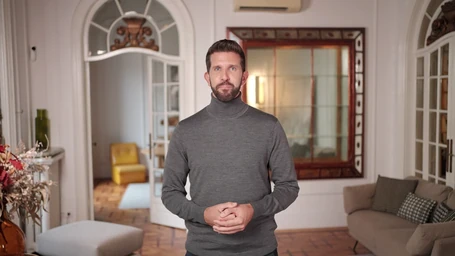10 Effective Ways on How to End a Welcome Speech with Impact
Wrapping up a welcome speech can feel like navigating through a maze—believe me, I understand the challenge of finding those perfect closing words that stick with your audience long after you’ve stepped down from the podium.
Through my own journey of trial and error, combined with extensive research, I’ve uncovered 10 powerful techniques for concluding your speech in a way that’s both memorable and impactful.
This blog post is your roadmap to ensuring your final words not only echo but also leave a lasting imprint on your listeners. Are you ready to leave them awestruck?
Key Takeaways
- Ending your speech with a powerful quote can make it memorable. A great quotation adds depth and inspiration.
- Issuing a challenge motivates your audience to act. It makes them remember and engage with your message long after the speech is over.
- Repetition helps highlight key points. Repeating important messages ensures they stick with your listeners.
- Linking main points back to the core message creates unity. This technique reinforces your key message effectively.
- Thanking the audience shows appreciation for their time and attention, leaving a positive impression as you conclude.
Why Ending a Speech Well is Important
Ending a speech well leaves a memorable impact and reinforces key messages. It creates a lasting impression on the audience.
Impact of a memorable conclusion
A memorable conclusion turns a good speech into an unforgettable one. I learned this the hard way but found that ending with impact keeps my message alive in the audience’s mind long after they leave.
Using strategies like a powerful call to action can direct them on what steps to take next, making my speech not just heard but acted upon. Repeating key points with clarity reinforces what I want them to remember most.
I also rely heavily on circling back to how I started. This bookend approach wraps up my talk neatly, offering a sense of completion and unity. Mixing in humor or an inspirational quote can lighten the mood or elevate the experience, leaving listeners with a positive lasting impression.
Every time I speak now, ending strongly is as important as starting strong because it’s my final moment to inspire, motivate, and connect.
The right words at the end of your speech can turn passivity into action.
Effective ways to close a speech are crucial for every speaker wanting their message remembered and acted upon.
Creating a lasting impression
As I wrap up my welcome speech, it’s essential to leave a lasting impression on the audience. This can be achieved by circling back to the beginning of the speech and using repetition for emphasis.
Additionally, incorporating humor into closing remarks can ensure that the audience leaves with a positive and memorable impression. Telling a captivating story or employing the rule of three in my conclusion will also help make an impact that resonates with the audience, leaving them with key takeaways from my address.
Reinforcing key messages
Reinforcing key messages at the end of a speech is crucial. It helps to drive home the main points and ensure that they stick with the audience. Using repetition can be effective in hammering home these key messages, making them more likely to resonate with your listeners even after the speech is over.
Additionally, circling back to the beginning of your speech can create a sense of closure and unity, reinforcing what you want your audience to take away from your words.
Repetition serves as a powerful tool for emphasizing main points and leaving a lasting impact on the audience. It also reinforces unity by linking back to the opening of the speech.
Effective Ways to Close a Speech
Here are effective ways to close a speech:
– Use a powerful quotation.
– Issue a challenge.
Use of a powerful quotation
When closing a speech, incorporating a powerful quotation can leave a lasting impact on the audience. A well-chosen quote from a famous figure or relevant source can resonate with the listeners, emphasizing the key message of your welcome speech and invoking inspiration.
For instance, during my early public speaking journey at Toastmasters International, I often closed my speeches by reciting impactful quotes that encapsulated the essence of my message.
This not only left a lasting impression but also added depth and credibility to my concluding remarks.
Issuing a challenge
Challenge yourself to end your welcome speech by encouraging the audience to take action. Express clearly what you want them to do after hearing your speech. This could be supporting a cause, making a change in their lives, or seeking further information on the topic.
By doing this, you’ll inspire engagement and ensure that your message has a lasting impact on the listeners. So, issue that challenge with confidence and watch as it resonates with your audience, driving home the purpose of your speech.
Utilizing a call back
As a public speaking beginner, I know the importance of making my speech memorable. Using a call back to reference an earlier point in the speech can create a sense of connection and unity with the audience.
By circling back to a key theme or idea from the beginning of my welcome speech, I can reinforce important messages and leave a lasting impact on my listeners. This technique helps in creating closure while ensuring that my speech feels cohesive and well-structured, leaving the audience with a strong impression.
Incorporating this strategy into your welcome speech can help you make it more impactful.
Incorporating a surprising fact
Did you know that incorporating a surprising fact into your closing speech can captivate the audience’s attention and leave a memorable impression? For example, revealing an unexpected statistic or little-known information related to your topic can create a sense of intrigue and engagement.
By incorporating a surprising fact, you can not only pique the audience’s curiosity but also reinforce the key messages of your welcome speech in a compelling way.
Implementing a visual image
I like to incorporate a compelling visual image at the end of my speeches to leave a lasting impression. Using a powerful visual can help reinforce the key message and evoke emotions in the audience, making the conclusion more memorable.
For instance, I once closed a welcome speech by displaying an impactful image that resonated with the main theme of my talk, leaving the audience with a strong and vivid memory.
Ending on a striking visual note can enhance engagement and make your speech more impactful. Remember, using visuals should complement your message and not distract from it, so choose carefully.
Now let’s move on to some common mistakes to avoid when closing a speech.
Common Mistakes to Avoid
Avoid ending with audience questions; Not planning an ending.
Not planning an ending
I once made the mistake of not planning an ending for my speech, and it left me feeling unprepared. It’s important to remember that concluding a speech is just as crucial as starting one.
Without a proper ending, the audience may feel uncertain about the key takeaways from your speech, leading to a lack of impact. Instead of leaving it open-ended or relying solely on audience questions to wrap up, take charge and craft a deliberate conclusion that reinforces your main points and leaves a lasting impression.
Trust me; I’ve seen how much of a difference this can make in captivating and engaging an audience.
Remember that failing to plan an ending can lead to uncertainty among your listeners, leaving them without clear direction or motivation at the end of your speech. Engaging with your audience until the very last word helps create trust and maintain their attention throughout your entire delivery.
Ending with audience questions
When concluding a welcome speech, avoid ending with audience questions as it can dilute the impact you want to make. It’s important to leave your audience with a memorable and impactful thought or call to action rather than opening up new threads of discussion.
Instead of asking for questions, use this opportunity to summarize your key points and leave your audience feeling inspired and motivated. Closing with an engaging statement or powerful quote can help solidify the message you want to convey, leaving a lasting impression on your audience.
Remember that ending with audience questions may diffuse the power of your conclusion.
Tips for a Memorable Conclusion
Ending a speech with impact is essential for leaving a lasting impression. Linking main points to the key message can create a sense of unity and reinforce your message effectively.
Use of repetition
Repetition is a powerful tool in closing a speech. It can reinforce key points and leave a lasting impact on the audience. By repeating essential messages, you emphasize their significance and make them memorable.
This approach helps drive home the main ideas, ensuring that they stick with the audience even after the speech has ended. Utilizing repetition effectively ensures that your audience understands and remembers your message, making it an impactful way to conclude a welcome speech.
Incorporating repetition in my speeches allows me to reinforce important ideas, leaving a strong impression on the audience while keeping them engaged. It’s about emphasizing key points for maximum impact and retention by using simple but effective repetition techniques.
Linking main points to key message
Linking the main points of your speech to the key message is crucial for ensuring that your audience remembers and understands your core ideas. By emphasizing these key points throughout your speech, you can reinforce your central message and leave a lasting impact.
It’s important to weave these main points into the conclusion of your speech, highlighting how they all lead back to the central theme or purpose. This linking strategy helps solidify the key message in the minds of your listeners, making it more likely that they will remember and act upon what you’ve shared.
Finishing with enthusiasm
Wrapping up a speech with enthusiasm is crucial for leaving a lasting impression. Engaging your audience till the end and concluding with energy can make your message stick. By conveying genuine excitement, you’ll inspire them to take action and remember what you’ve shared.
Thanking the audience in an enthusiastic tone also helps to show appreciation for their time and attention. A positive and lively conclusion can leave a strong impact that lingers on even after the speech ends.
Encouraging action
As we wrap up our welcome speech, I encourage you to take action. Let’s conclude with a strong call to action, telling the audience what we want them to do next after hearing us speak.
It’s crucial to leave the listeners with a clear direction and purpose moving forward. We aim for our words to inspire and motivate them into taking meaningful steps or making positive changes based on what they’ve heard today.
Remember that ending with an impactful call to action can empower and mobilize the audience towards creating real change or embracing new ideas. Your ability as speakers to prompt your audience into action is key in ensuring that your message doesn’t just end at the conclusion of your speech but continues beyond it, bringing about tangible results.
Thanking the audience
Thank you for your attention. Your presence means a lot to me. I hope these tips will help boost your confidence and keep your audience engaged till the end of your welcome speech.
Conclusion
Wrapping up a talk with impact matters a lot. Dr. Elizabeth Moreno has spent over two decades coaching speakers on powerful closings. With degrees in Communication and Public Speaking, her work has transformed many into confident speakers.
Dr. Moreno stresses the importance of closing techniques like quotations and challenges for leaving audiences inspired. She points out that ending well can reinforce your message and make it memorable.
She raises concerns about safety in figurative speech, urging speakers to choose words carefully to avoid misunderstandings. Ethical considerations matter too, especially when quoting others or presenting facts.
For everyday speeches, Dr. Moreno suggests practicing endings that resonate personally before diving into public speaking forums. This approach ensures authenticity and impact.
Comparing common closing strategies, she notes while some may seem outdated, classics like storytelling often hold power due to their emotional resonance.
Finally, Dr. Moreno believes mastering the art of concluding a welcome address greatly enhances its effectiveness. Embracing these practices not only impacts our audience but also evolves our presentation skills for the better.
Meet Alex Kolek, your guide through the treacherous world of not sucking at public speaking. Once a sweaty-palmed, tongue-tied disaster in the corporate jungle, Alex spent years perfecting the art of blending into boardroom walls. But after one too many career-threatening presentations, he decided to grab the corporate bull by the horns. Through sheer desperation and a healthy dose of humor, Alex transformed himself from a public speaking coward into a presentation powerhouse. He climbed the corporate ladder, leaving a trail of impressed executives and engaged audiences in his wake.







